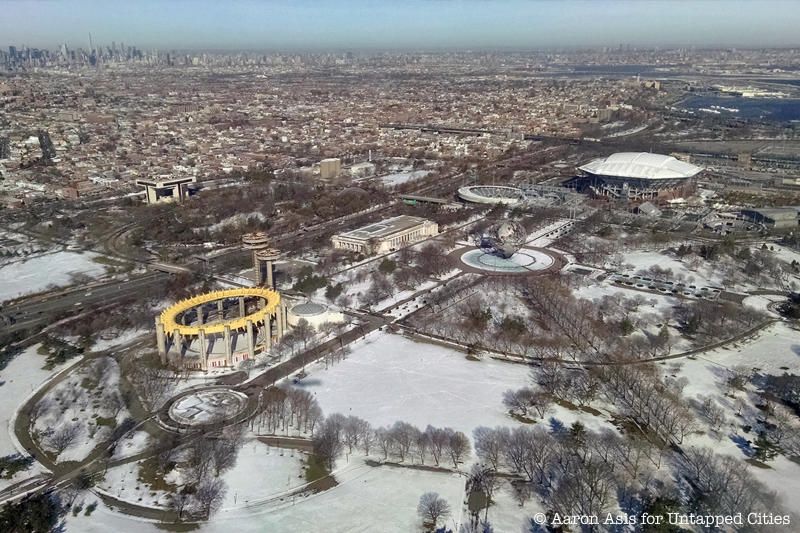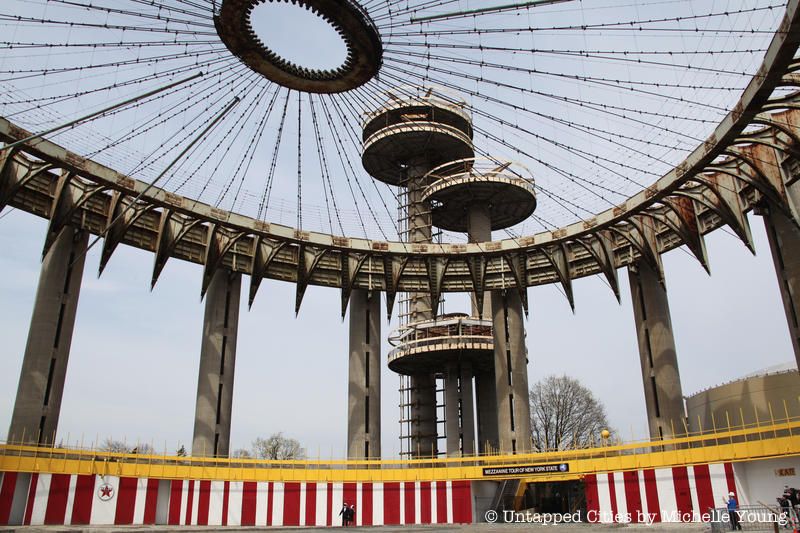Vintage 1970s Photos Show Lost Sites of NYC's Lower East Side
A quest to find his grandmother's birthplace led Richard Marc Sakols on a mission to capture his changing neighborhood on film.


This op-ed is written by the organization People for the Pavilion,a volunteer-run 501(c)3 non-profit organization devoted to raising awareness of the historic value of the New York State Pavilion, and of its potential to serve as a vibrant and functional public space.
A crowd-funding campaign led by the National Trust for Historic Preservation and The Cities Project by Heineken is the latest in a series of ongoing efforts to raise awareness and funding for the New York State Pavilion in Flushing Meadows-Corona Park. The campaign will help the New York City Department of Parks & Recreation make critical repairs to the entryway of the structure, and is providing some serious perks in return for contributions, including T-shirts, exclusive illustrations of the Pavilion, and tickets to the “Bruno Mars: 24K Magic World Tour.”
Additionally, Untapped Cities is offering a free, special access tour of the Philip Johnson-designed Pavilion, through a giveaway of its own. Led by Mitch Silverstein, founder of the New York State Pavilion Paint Project, the tour is being offered in partnership with the National Trust for Historic Preservation and NYC Parks. Sign up for entries to this giveaway here, and continue reading the op-ed below:
No preservation project in recent memory has received the attention and care that the Pavilion has from across the City and the country. Local organizations like ours have worked for years to build a community around the structure through programming and events, including a worldwide ideas competition in partnership with the National Trust for Historic Preservation. The New York State Pavilion Paint Crew has spent nearly a decade working to maintain the structure with new coats of paint. People for the Pavilion Co-Founder Matthew Silva’s documentary, Modern Ruin, has helped raise the profile of the Pavilion, and the structure has even found itself in an ad campaign for Streeteasy and on the cover of the NYC DOT 2016 Bike Map. The New York Structural Steel Painting Contractors Association donated time and resources to repainting the structure in 2015, and last fall the City Reliquary held a Pavilion-focused exhibit. Media outlets like Untapped Cities have highlighted these activities along the way, helping to shine a light on the iconic structure.
In an instance of true New York City solidarity, preserving the Pavilion is not a fight – it seems everyone is on board, and is chipping in to help NYC Parks and Borough President Katz bring this incredible structure back to life. In April, the City announced it is giving the Pavilion a $14.25 million redesign. The Parks Department recently approved the schematic design, and Queens Community Board 7 signed off on the plans.

While there is still work to be done, in the hands of the leadership of NYC Parks and the Borough President, the Pavilion is safe from the wrecking ball. With a more certain future in place, the question now is how to ensure that the narrative of the structure driven not simply by nostalgia, but with an eye toward the future, and an emphasis on the communities that now reside around it. The Queens of 2017 is vastly different than the one of 1964 – it is the most ethnically diverse urban area in the world, with 138 different languages spoken, and a population that is nearly 30% more than it was when the Fair closed in 1965.
To the constituencies around Flushing Meadows, the Pavilion is not a simply a relic from the World’s Fair, but one from their own lives. Millions have grown up in its shadow, knowing it only as a closed and empty portion of Flushing Meadows Corona Park.

In December, New York City Council Member Mark Levine held a New York City Council Parks Committee Public Hearing on opening Parks properties currently closed to the public. This conversation was an important step, and a reminder that this effort is part of a larger movement to restore life to public structures.
“New York’s Parks hold so many treasures, but sadly, many are off-limits. Buildings, monuments, even entire islands are owned by the Parks department, but closed to New Yorkers,” said Moses Gates, Director of Community Planning and Design for the Regional Plan Association. “But things are changing, and many are being restored and reopened, places like McCarren Pool in Brooklyn and the High Bridge between Upper Manhattan and the Bronx.”
The Pavilion can and should continue to be an international symbol of the World’s Fair, but as the Tent of Tomorrow once suggested, it is essential to look toward the future. The Pavilion is as much a part of history as it is a part of the community surrounding it today, and the focus should now shift to its neighbors. As the City continues to allocate funds and manage the difficult task of design, procurement, and construction, the question of ‘access’ will become critically important in helping to define what the structure will mean to those who call it a part of their backyard. It will either reinforce or diminish the sense of ownership felt by those who live and play in its shadow. How this happens will be up to City leadership, and the local and national organizations who have worked so hard to bring attention back to this incredible part of New York City.
Try and win a spot on Untapped Cities’ Special Access Tour Inside the New York State Pavilion on June 10th. Enter before June 3rd!
Subscribe to our newsletter